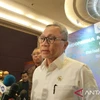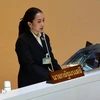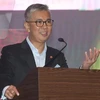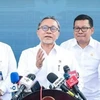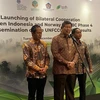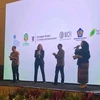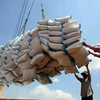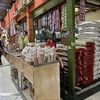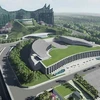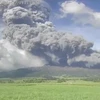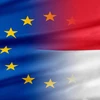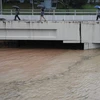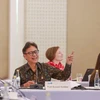The East Asia Summit (EAS) continued to be a forum for regional leaders to exchange views on and talk issues of strategic importance relating to regional peace, security and development.
EAS foreign ministers made the affirmation at a meeting in the Indonesian island of Bali on July 22, which aimed to discuss EAS cooperation priorities and preparations for the ASEAN Summit with relevant partners, especially the 16 th EAS to be held in Bali in November this year.
According to the ministers, in addition to the current five priority cooperative areas of finance, energy, education, bird flu prevention and disaster control, the EAS should promote cooperation in fields of common interest, such as cooperation in boosting economic connectivity through the Comprehensive Economic Partnership in East Asia (CEPEA) and non-traditional security issues.
The ministers welcomed the participation of Russia and the US in the EAS.
They affirmed that the expanded EAS would continue to be an important component of the shaping regional architecture, with ASEAN playing the central role.
They pledged to maintain and speed up the objectives, principles and institutions of the EAS stated in the 2005 Kuala Lumpur Declaration and 2010 Hanoi Declaration; and strengthen mutual assistance between existing regional mechanisms, including EAS, ASEAN+3, ADMM+ and ARF, in order to effectively contribute to peace, stability and development in the region.
On the same day, the ASEAN Ministerial Meetings with Canada , India and New Zealand took place in Bali under the PMC+1 mechanism.
At the ASEAN-Canada Ministerial Meeting, ministers agreed to effectively implement the ASEAN-Canada Action Plan in the 2010-2015 period and strengthen cooperation in trade, investment, agriculture, non-traditional security, including food and energy security, disaster control and transnational crime prevention.
They also agreed to speed up initiatives and activities towards the 35 th anniversary of the ASEAN-Canada dialogue relations in 2012.
At the ASEAN-India Ministerial Meeting, the ASEAN countries highly valued India ’s “Look East” policy as well as the country’s active and effective support for the building of the ASEAN Community, helping ASEAN narrow development gaps and enhance its central role in the shaping regional architecture.
The ministers suggested the two parties continue to implement the ASEAN-India Action Plan in the 2010-2015 period, accelerate negotiations for the Agreement on Trade, Services and Investment, as well as strengthen cooperation in such fields as agriculture, transport, tourism, information technology and biology.
The two sides agreed on a list of activities towards a summit celebrating the 20 th anniversary of the ASEAN-India dialogue relations in 2012.
At the ASEAN-New Zealand Ministerial Meeting, the ministers reviewed the implementation of the 2010-2015 ASEAN-New Zealand Action Plan and decisions of the Summit celebrating the 35 th anniversary of dialogue relations in October, 2010.
They agreed to effectively implement the agreement on the establishment of the ASEAN-Australia-New Zealand Free Trade Agree (AANZFTA) as well as strengthen cooperation in education, people-to-people exchanges and disaster control.
Speaking at these meetings, Vietnamese Deputy PM and FM Pham Gia Khiem suggested the partners continue to provide effective support and assistance for ASEAN to build the Community, narrow development gaps and strengthen regional connectivity, as well as support the key role of ASEAN in regional mechanisms and forums such as ASEAN+1, ASEAN+3, EAS, ARF and ADMM+.
He also urged the partners to make more contributions to peace, security, stability and development in the region.
Response to natural disasters and maritime security are issues of common regional concern, so ASEAN and its partners should continue cooperation in effectively coping with natural calamities and in maritime security on the basis of abiding by international law, especially the 1982 UN Convention on the Law of the Sea (UNCLOS), he said.
On the same day, the Vietnamese Deputy PM attended a ministerial meeting between lower Mekong countries and the US , and a dialogue between lower Mekong countries and friends, including Australia , the EU, Japan , the Republic of Korea and the US .
Earlier, the ASEAN ministerial meetings with Russia , the US and the EU took place./.
EAS foreign ministers made the affirmation at a meeting in the Indonesian island of Bali on July 22, which aimed to discuss EAS cooperation priorities and preparations for the ASEAN Summit with relevant partners, especially the 16 th EAS to be held in Bali in November this year.
According to the ministers, in addition to the current five priority cooperative areas of finance, energy, education, bird flu prevention and disaster control, the EAS should promote cooperation in fields of common interest, such as cooperation in boosting economic connectivity through the Comprehensive Economic Partnership in East Asia (CEPEA) and non-traditional security issues.
The ministers welcomed the participation of Russia and the US in the EAS.
They affirmed that the expanded EAS would continue to be an important component of the shaping regional architecture, with ASEAN playing the central role.
They pledged to maintain and speed up the objectives, principles and institutions of the EAS stated in the 2005 Kuala Lumpur Declaration and 2010 Hanoi Declaration; and strengthen mutual assistance between existing regional mechanisms, including EAS, ASEAN+3, ADMM+ and ARF, in order to effectively contribute to peace, stability and development in the region.
On the same day, the ASEAN Ministerial Meetings with Canada , India and New Zealand took place in Bali under the PMC+1 mechanism.
At the ASEAN-Canada Ministerial Meeting, ministers agreed to effectively implement the ASEAN-Canada Action Plan in the 2010-2015 period and strengthen cooperation in trade, investment, agriculture, non-traditional security, including food and energy security, disaster control and transnational crime prevention.
They also agreed to speed up initiatives and activities towards the 35 th anniversary of the ASEAN-Canada dialogue relations in 2012.
At the ASEAN-India Ministerial Meeting, the ASEAN countries highly valued India ’s “Look East” policy as well as the country’s active and effective support for the building of the ASEAN Community, helping ASEAN narrow development gaps and enhance its central role in the shaping regional architecture.
The ministers suggested the two parties continue to implement the ASEAN-India Action Plan in the 2010-2015 period, accelerate negotiations for the Agreement on Trade, Services and Investment, as well as strengthen cooperation in such fields as agriculture, transport, tourism, information technology and biology.
The two sides agreed on a list of activities towards a summit celebrating the 20 th anniversary of the ASEAN-India dialogue relations in 2012.
At the ASEAN-New Zealand Ministerial Meeting, the ministers reviewed the implementation of the 2010-2015 ASEAN-New Zealand Action Plan and decisions of the Summit celebrating the 35 th anniversary of dialogue relations in October, 2010.
They agreed to effectively implement the agreement on the establishment of the ASEAN-Australia-New Zealand Free Trade Agree (AANZFTA) as well as strengthen cooperation in education, people-to-people exchanges and disaster control.
Speaking at these meetings, Vietnamese Deputy PM and FM Pham Gia Khiem suggested the partners continue to provide effective support and assistance for ASEAN to build the Community, narrow development gaps and strengthen regional connectivity, as well as support the key role of ASEAN in regional mechanisms and forums such as ASEAN+1, ASEAN+3, EAS, ARF and ADMM+.
He also urged the partners to make more contributions to peace, security, stability and development in the region.
Response to natural disasters and maritime security are issues of common regional concern, so ASEAN and its partners should continue cooperation in effectively coping with natural calamities and in maritime security on the basis of abiding by international law, especially the 1982 UN Convention on the Law of the Sea (UNCLOS), he said.
On the same day, the Vietnamese Deputy PM attended a ministerial meeting between lower Mekong countries and the US , and a dialogue between lower Mekong countries and friends, including Australia , the EU, Japan , the Republic of Korea and the US .
Earlier, the ASEAN ministerial meetings with Russia , the US and the EU took place./.

